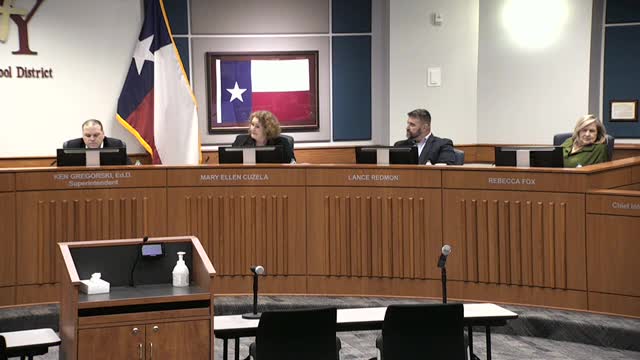External auditors give Katy ISD a clean opinion; general fund ends FY24 with $364.3 million
January 13, 2025 | KATY ISD, School Districts, Texas
This article was created by AI summarizing key points discussed. AI makes mistakes, so for full details and context, please refer to the video of the full meeting. Please report any errors so we can fix them. Report an error »

Katy Independent School District’s external auditors reported an unmodified (clean) opinion on the district’s fiscal 2024 financial statements during the Jan. 13 board work‑study meeting.
Lupe Garcia, partner with Whitley Penn LLP, told trustees the audit work — which included interim testing in May–June and year‑end fieldwork in November — produced an unmodified opinion on the annual comprehensive financial report and found no material weaknesses in internal control or noncompliance for the financial statements and federal grant programs that were tested.
“We are happy to report that our opinion on the district’s financial statements for the 2024 fiscal period is that unmodified opinion,” Garcia said.
Key audit findings and financial highlights
- Fund balance: The district reported an increase in general‑fund balance of approximately $11.5 million for FY2024, producing an ending total general‑fund balance of $364.3 million. Unassigned fund balance was reported at $273.7 million, equal to about 26.7% of general‑fund expenditures.
- Revenue mix: The audit summary presented general‑fund revenue composition for FY2024 as roughly 52% state funding and 38% property taxes (with remaining sources accounting for single‑digit shares and small federal amounts included in the general fund). Auditors noted prior policy and state changes — such as the homestead exemption expansion and property tax rate compression — changed the composition of revenues year over year.
- Pension and OPEB: The audit included required reporting of the district’s proportionate shares of statewide pension and retiree‑health liabilities; auditors explained the teacher pension plan maintained a funded ratio in the mid‑70s, while the retiree health plan remains largely on a pay‑as‑you‑go basis.
Garcia praised district staff for cooperation during the multi‑month audit process and said auditors identified no reportable misstatements, disagreements with management or findings requiring corrective action.
Why it matters
A clean audit opinion is a standard expectation for large public school districts, but it also underpins external credit‑rating and bond market communications and is a public transparency measure required by state law. District staff said they will submit the report to recognized financial and accounting award programs and upload the data required for state reporting.
Ending
Trustees thanked district financial staff and the audit team; staff said they will use the audited figures in upcoming budget work and in debt‑service planning to be presented to the board.
Lupe Garcia, partner with Whitley Penn LLP, told trustees the audit work — which included interim testing in May–June and year‑end fieldwork in November — produced an unmodified opinion on the annual comprehensive financial report and found no material weaknesses in internal control or noncompliance for the financial statements and federal grant programs that were tested.
“We are happy to report that our opinion on the district’s financial statements for the 2024 fiscal period is that unmodified opinion,” Garcia said.
Key audit findings and financial highlights
- Fund balance: The district reported an increase in general‑fund balance of approximately $11.5 million for FY2024, producing an ending total general‑fund balance of $364.3 million. Unassigned fund balance was reported at $273.7 million, equal to about 26.7% of general‑fund expenditures.
- Revenue mix: The audit summary presented general‑fund revenue composition for FY2024 as roughly 52% state funding and 38% property taxes (with remaining sources accounting for single‑digit shares and small federal amounts included in the general fund). Auditors noted prior policy and state changes — such as the homestead exemption expansion and property tax rate compression — changed the composition of revenues year over year.
- Pension and OPEB: The audit included required reporting of the district’s proportionate shares of statewide pension and retiree‑health liabilities; auditors explained the teacher pension plan maintained a funded ratio in the mid‑70s, while the retiree health plan remains largely on a pay‑as‑you‑go basis.
Garcia praised district staff for cooperation during the multi‑month audit process and said auditors identified no reportable misstatements, disagreements with management or findings requiring corrective action.
Why it matters
A clean audit opinion is a standard expectation for large public school districts, but it also underpins external credit‑rating and bond market communications and is a public transparency measure required by state law. District staff said they will submit the report to recognized financial and accounting award programs and upload the data required for state reporting.
Ending
Trustees thanked district financial staff and the audit team; staff said they will use the audited figures in upcoming budget work and in debt‑service planning to be presented to the board.
View full meeting
This article is based on a recent meeting—watch the full video and explore the complete transcript for deeper insights into the discussion.
View full meeting
